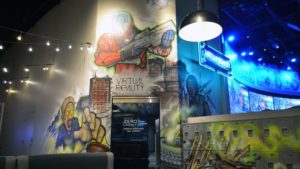Zero Latency’s Next Title is Tackling the Challenges of Location-based PVP
 Zero Latency is an Australia-based creator of a VR attraction platform and content. Since its founding in 2013, the company has launched five co-op VR games supporting up to eight players. The company’s latest game, Sol Raiders, is the first to pit players against each other in a 4 vs. 4 format.
Zero Latency is an Australia-based creator of a VR attraction platform and content. Since its founding in 2013, the company has launched five co-op VR games supporting up to eight players. The company’s latest game, Sol Raiders, is the first to pit players against each other in a 4 vs. 4 format.
With 25 locations now in operation around the globe, Zero Latency is one of the leading VR attraction platforms today. The company develops the hardware, software, and content for the platform, which allows up to eight users to simultaneously play a shared virtual reality experience which unfolds in a large physical playspace that’s 60 × 30 ft (~18.3 × 9 m).
Zero Latency claims impressive growth over the last three years, culminating in 300,000 unique players and 420,000 unique plays in 2018 alone. At roughly $50 USD per play (with regional variances), the company’s platform appears to be generating tens of millions in revenue annually.
I visited the company’s Las Vegas location at the MGM Grand hotel and casino to preview the game first-hand.
‘The rift’ is a sub-reality of sorts which handles one of the most challenging elements of free-roam VR PVP gameplay: space management. When players die, they are teleported to the rift which looks sort of like being inside of a sci-fi wormhole, but with a concrete floor that’s crawling with ghost-like avatars. The avatars represent every other real player in the arena, allowing dead players to run back to a pre-defined spawn point without bumping into others. Once the dead player makes their way back to their spawn point, they are spawned back to life on the map proper.
It might sound a bit complicated on paper, but it works surprisingly well and doesn’t require players to really understand what the rift’s function is behind the scenes.
As PVP action is more fast-paced and a bit more frantic than the co-op games, it’s important that players not come too close to each other for fear of bumping into one another or accidentally smacking someone with the hefty gun. To create some buffer space around players, the avatars are oversized from the start, including virtual guns which are quite a bit longer and larger than their real-life counterparts.
Zero Latency further uses virtual space distortion to turn Sol Raiders into something that’s dynamic in ways that real life small arena attractions like paintball or laser tag can’t be because of their physical limitations. The best example of this is on the third map where players from each side ride small gondolas away from their base towards a central platform where lots of close quarters fighting happens. In virtual reality, players feel like they’ve moved across a large space, but in reality they’re still standing right next to where they started.
Zero Latency recently announced that it’s working with HP and Microsoft to formulate its next-gen hardware platform, which will hopefully do even more to capitalize on the company’s impressive content development work.
Pages
- About Philip Lelyveld
- Mark and Addie Lelyveld Biographies
- Presentations and articles
- Tufts Alumni Bio